Hyundai Getz 2004 Owner's Manual
Manufacturer: HYUNDAI, Model Year: 2004, Model line: Getz, Model: Hyundai Getz 2004Pages: 445, PDF Size: 12.16 MB
Page 341 of 445
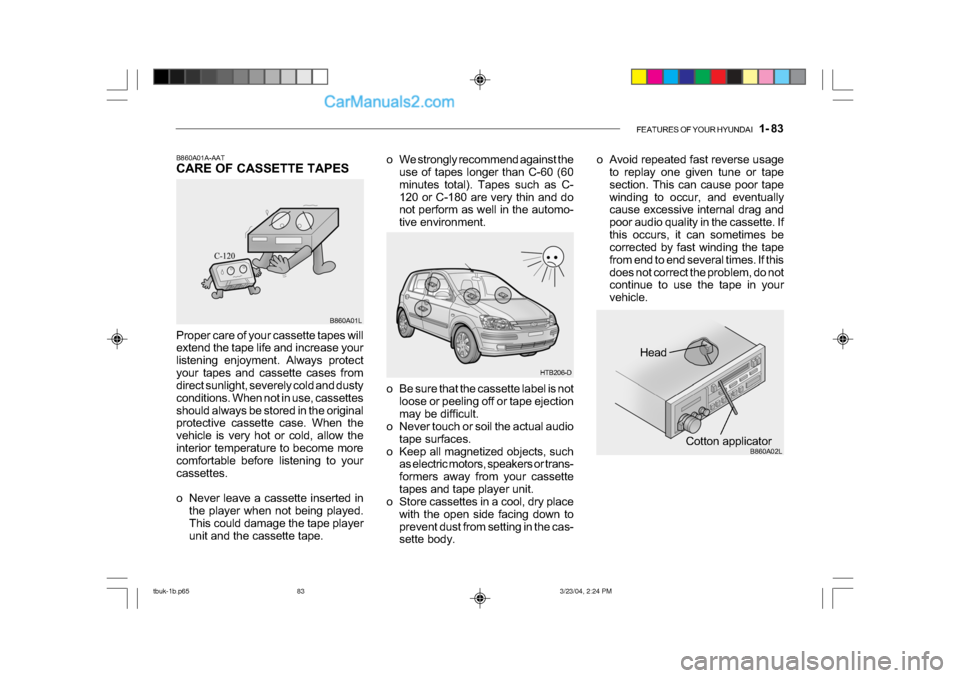
FEATURES OF YOUR HYUNDAI 1- 83
Head
Cotton applicator B860A02L
o Be sure that the cassette label is not
loose or peeling off or tape ejection
may be difficult.
o Never touch or soil the actual audio
tape surfaces.
o Keep all magnetized objects, such as electric motors, speakers or trans-
formers away from your cassette
tapes and tape player unit.
o Store cassettes in a cool, dry place
with the open side facing down to
prevent dust from setting in the cas-
sette body.
o We strongly recommend against the
use of tapes longer than C-60 (60
minutes total). Tapes such as C-
120 or C-180 are very thin and do
not perform as well in the automo-
tive environment. o Avoid repeated fast reverse usage
to replay one given tune or tape
section. This can cause poor tape
winding to occur, and eventually
cause excessive internal drag and
poor audio quality in the cassette. If
this occurs, it can sometimes be
corrected by fast winding the tape
from end to end several times. If this
does not correct the problem, do not
continue to use the tape in your
vehicle.
B860A01A-AAT
CARE OF CASSETTE TAPES
Proper care of your cassette tapes will
extend the tape life and increase your
listening enjoyment. Always protect
your tapes and cassette cases from
direct sunlight, severely cold and dusty
conditions. When not in use, cassettes
should always be stored in the original
protective cassette case. When the
vehicle is very hot or cold, allow the
interior temperature to become more
comfortable before listening to your
cassettes.
o Never leave a cassette inserted in
the player when not being played.
This could damage the tape player
unit and the cassette tape. B860A01L
HTB206-D
tbuk-1b.p65
3/23/04, 2:24 PM
83
Page 342 of 445

1- 84 FEATURES OF YOUR HYUNDAI
HTB111
B870D01FC-GAT
ANTENNA
Roof Antenna
Your car uses a roof antenna to re-
ceive both AM and FM broadcast sig-
nals.
This antenna is a removable type. To
remove the antenna, turn the antenna
counterclockwise. To install the an-
tenna, turn the antenna clockwise.
o The playback head, capstan and
pinch rollers will develop a coating
of tape residue that can result in
deterioration of sound quality, such
as a wavering sound. They should
be cleaned monthly using a com-
mercially available head cleaning
tape or special solution available
from audio specialty shops. Follow
the supplier's directions carefully and
never oil any part of the tape player
unit.
o Always be sure that the tape is tightly wound on its reel before in-
serting in the player. Rotate a pencil
in the drive sprockets to wind up any
slack. B860A03L
NOTE:
Look at a tape before you insert it.
If the tape is loose, tighten it by
turning one of the hubs with a pen-
cil or your finger.
If the label is peeling off, do not put
it in the drive mechanism.
Do not leave tapes sitting where
they are exposed to hot, warm, or
high humidity, such as on top of
the dashboard or in the player.
If a tape is exposed to extreme heat
or cold, let it reach a moderate tem-
perature before putting it in the
player.
tbuk-1b.p65 3/23/04, 2:24 PM
84
Page 343 of 445
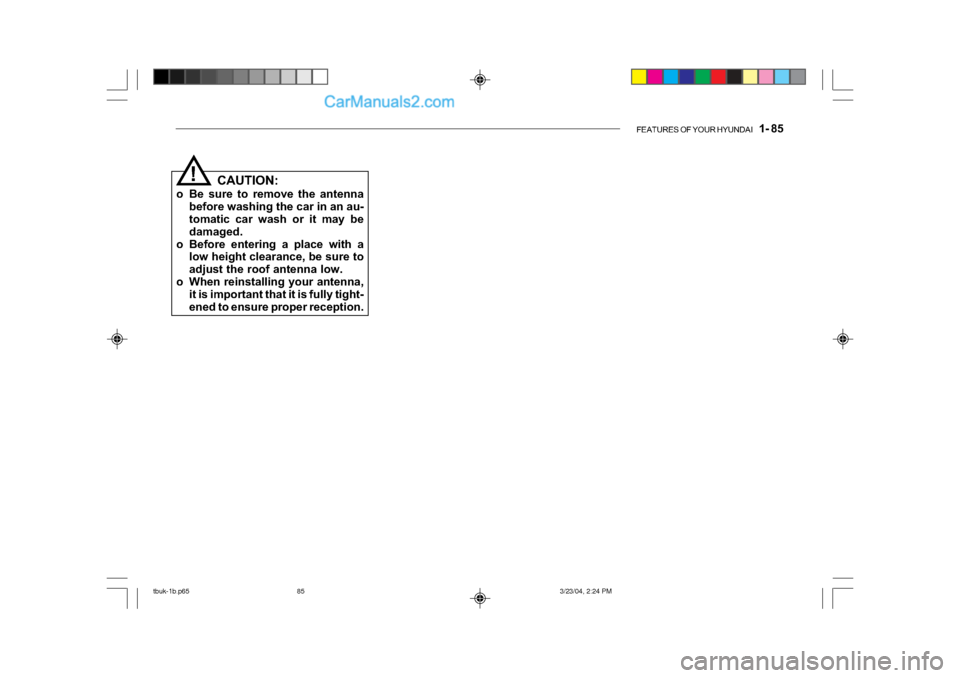
FEATURES OF YOUR HYUNDAI 1- 85
CAUTION:
o Be sure to remove the antenna before washing the car in an au-
tomatic car wash or it may be
damaged.
o Before entering a place with a low height clearance, be sure to
adjust the roof antenna low.
o When reinstalling your antenna, it is important that it is fully tight-
ened to ensure proper reception.!
tbuk-1b.p65 3/23/04, 2:24 PM
85
Page 344 of 445
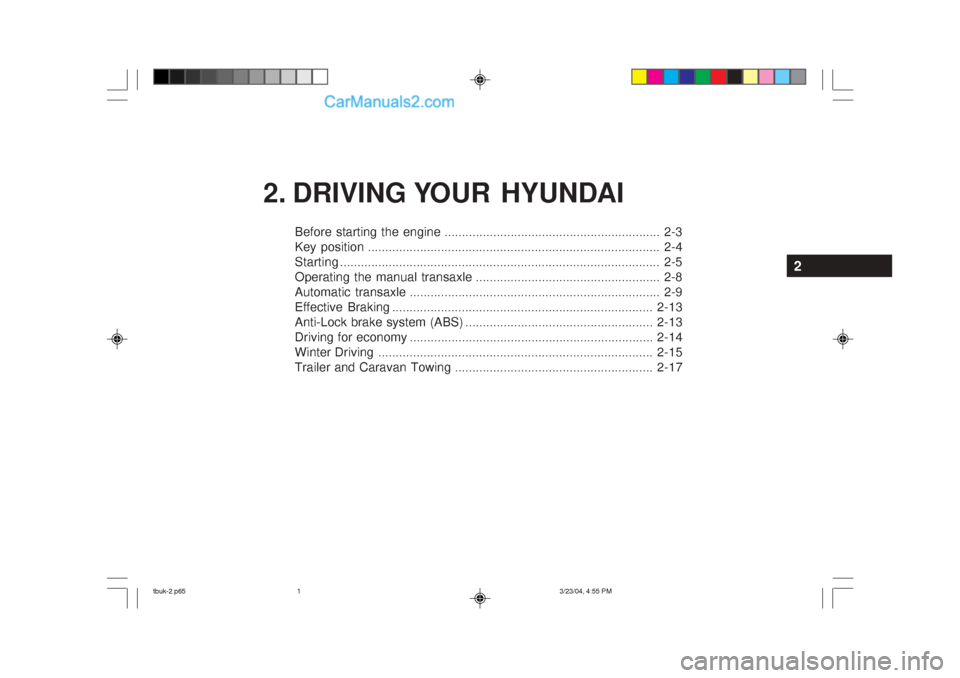
2. DRIVING YOUR HYUNDAIBefore starting the engine .............................................................. 2-3
Key position .................................................................................... 2-4Starting ............................................................................................ 2-5
Operating the manual transaxle ..................................................... 2-8
Automatic transaxle ........................................................................ 2-9
Effective Braking ........................................................................... 2-13
Anti-Lock brake system (ABS) ...................................................... 2-13
Driving for economy ...................................................................... 2-14
Winter Driving ............................................................................... 2-15
Trailer and Caravan Towing ......................................................... 2-17
2
tbuk-2.p65 3/23/04, 4:55 PM
1
Page 345 of 445
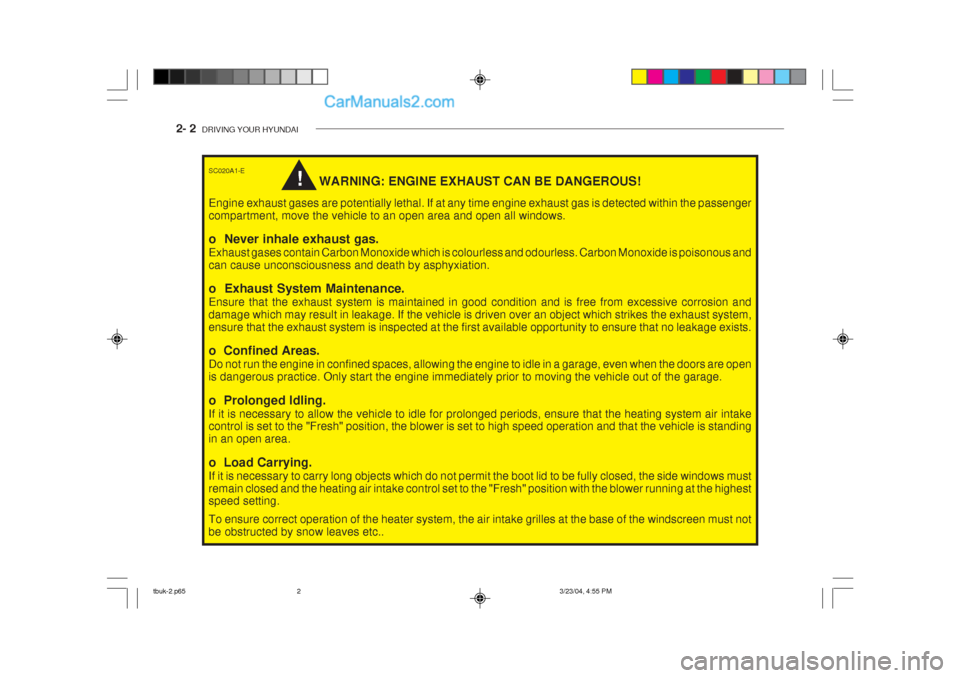
2- 2 DRIVING YOUR HYUNDAI
!
SC020A1-E
WARNING: ENGINE EXHAUST CAN BE DANGEROUS!
Engine exhaust gases are potentially lethal. If at any time engine exhaust gas is detected within the passenger compartment, move the vehicle to an open area and open all windows. o Never inhale exhaust gas. Exhaust gases contain Carbon Monoxide which is colourless and odourless. Carbon Monoxide is poisonous and can cause unconsciousness and death by asphyxiation. o Exhaust System Maintenance. Ensure that the exhaust system is maintained in good condition and is free from excessive corrosion and damage which may result in leakage. If the vehicle is driven over an object which strikes the exhaust system,ensure that the exhaust system is inspected at the first available opportunity to ensure that no leakage exists. o Confined Areas. Do not run the engine in confined spaces, allowing the engine to idle in a garage, even when the doors are open is dangerous practice. Only start the engine immediately prior to moving the vehicle out of the garage. o Prolonged Idling. If it is necessary to allow the vehicle to idle for prolonged periods, ensure that the heating system air intake control is set to the "Fresh" position, the blower is set to high speed operation and that the vehicle is standing in an open area. o Load Carrying. If it is necessary to carry long objects which do not permit the boot lid to be fully closed, the side windows must remain closed and the heating air intake control set to the "Fresh" position with the blower running at the highest speed setting. To ensure correct operation of the heater system, the air intake grilles at the base of the windscreen must not be obstructed by snow leaves etc..
tbuk-2.p65 3/23/04, 4:55 PM
2
Page 346 of 445
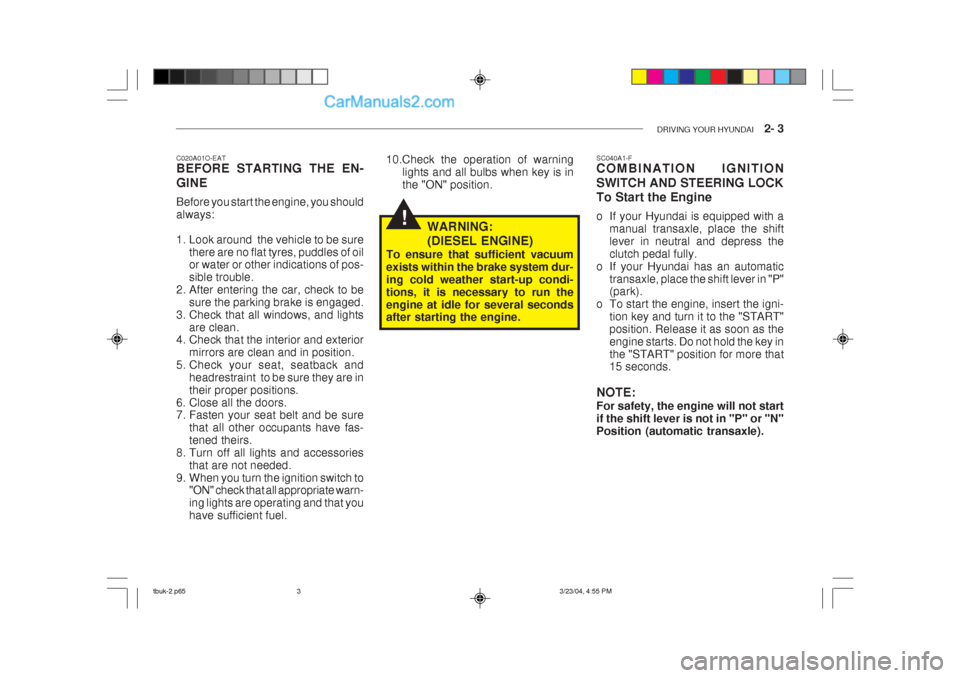
DRIVING YOUR HYUNDAI 2- 3
!
C020A01O-EAT BEFORE STARTING THE EN- GINE Before you start the engine, you should always:
1. Look around the vehicle to be sure
there are no flat tyres, puddles of oil or water or other indications of pos- sible trouble.
2. After entering the car, check to be
sure the parking brake is engaged.
3. Check that all windows, and lights are clean.
4. Check that the interior and exterior
mirrors are clean and in position.
5. Check your seat, seatback and
headrestraint to be sure they are intheir proper positions.
6. Close all the doors.
7. Fasten your seat belt and be sure
that all other occupants have fas- tened theirs.
8. Turn off all lights and accessories that are not needed.
9. When you turn the ignition switch to "ON" check that all appropriate warn-ing lights are operating and that youhave sufficient fuel. 10.Check the operation of warning
lights and all bulbs when key is inthe "ON" position.
WARNING: (DIESEL ENGINE)
To ensure that sufficient vacuum exists within the brake system dur-ing cold weather start-up condi-tions, it is necessary to run theengine at idle for several seconds after starting the engine. SC040A1-F COMBINATION IGNITION SWITCH AND STEERING LOCK To Start the Engine
o If your Hyundai is equipped with a
manual transaxle, place the shift lever in neutral and depress theclutch pedal fully.
o If your Hyundai has an automatic
transaxle, place the shift lever in "P" (park).
o To start the engine, insert the igni-
tion key and turn it to the "START" position. Release it as soon as theengine starts. Do not hold the key inthe "START" position for more that 15 seconds.
NOTE: For safety, the engine will not start if the shift lever is not in "P" or "N"Position (automatic transaxle).
tbuk-2.p65 3/23/04, 4:55 PM
3
Page 347 of 445
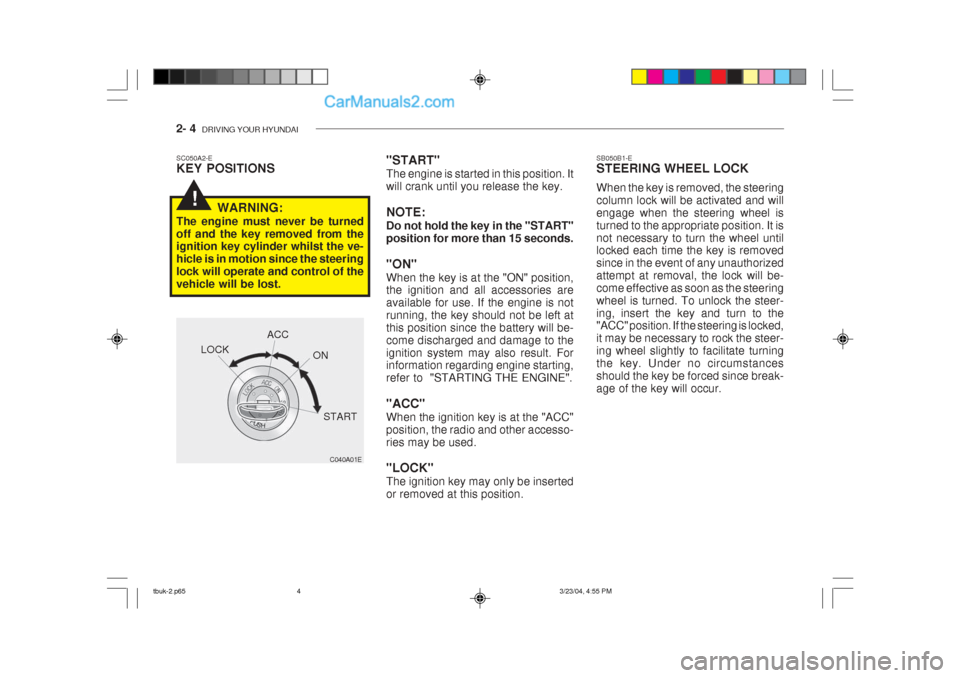
2- 4 DRIVING YOUR HYUNDAI
!
"START" The engine is started in this position. It will crank until you release the key. NOTE: Do not hold the key in the "START" position for more than 15 seconds. "ON" When the key is at the "ON" position, the ignition and all accessories are available for use. If the engine is notrunning, the key should not be left atthis position since the battery will be-come discharged and damage to theignition system may also result. For information regarding engine starting, refer to "STARTING THE ENGINE". "ACC" When the ignition key is at the "ACC" position, the radio and other accesso-ries may be used. "LOCK" The ignition key may only be inserted or removed at this position.SC050A2-E KEY POSITIONS
C040A01E
LOCK
ACC
ON
START
WARNING:
The engine must never be turned off and the key removed from the ignition key cylinder whilst the ve- hicle is in motion since the steeringlock will operate and control of thevehicle will be lost. SB050B1-E STEERING WHEEL LOCK When the key is removed, the steering column lock will be activated and willengage when the steering wheel isturned to the appropriate position. It isnot necessary to turn the wheel until locked each time the key is removed since in the event of any unauthorizedattempt at removal, the lock will be-come effective as soon as the steeringwheel is turned. To unlock the steer-ing, insert the key and turn to the "ACC" position. If the steering is locked, it may be necessary to rock the steer-ing wheel slightly to facilitate turningthe key. Under no circumstancesshould the key be forced since break-age of the key will occur.
tbuk-2.p65
3/23/04, 4:55 PM
4
Page 348 of 445
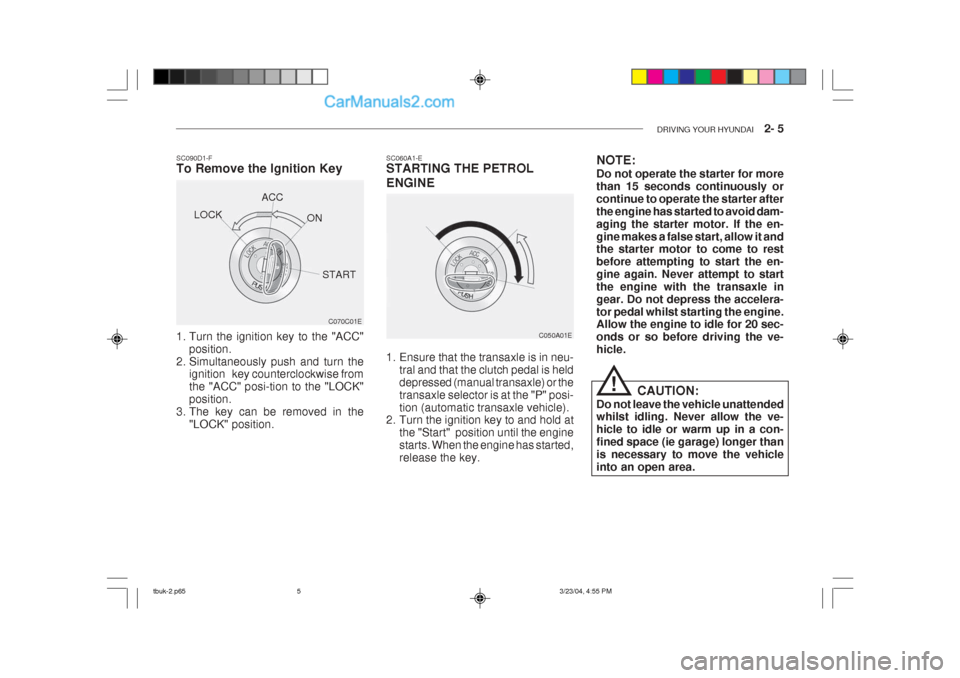
DRIVING YOUR HYUNDAI 2- 5
SC060A1-E STARTING THE PETROL ENGINE
C050A01E
1. Ensure that the transaxle is in neu- tral and that the clutch pedal is held depressed (manual transaxle) or thetransaxle selector is at the "P" posi-tion (automatic transaxle vehicle).
2. Turn the ignition key to and hold at
the "Start" position until the enginestarts. When the engine has started,release the key.
C070C01E
SC090D1-F To Remove the Ignition Key
1. Turn the ignition key to the "ACC"
position.
2. Simultaneously push and turn the ignition key counterclockwise from the "ACC" posi-tion to the "LOCK"position.
3. The key can be removed in the
"LOCK" position.LOCK
ACC
ON
START NOTE: Do not operate the starter for more than 15 seconds continuously orcontinue to operate the starter afterthe engine has started to avoid dam-aging the starter motor. If the en-gine makes a false start, allow it and the starter motor to come to rest before attempting to start the en-gine again. Never attempt to startthe engine with the transaxle ingear. Do not depress the accelera-tor pedal whilst starting the engine. Allow the engine to idle for 20 sec- onds or so before driving the ve-hicle.
CAUTION:
Do not leave the vehicle unattended whilst idling. Never allow the ve- hicle to idle or warm up in a con-fined space (ie garage) longer thanis necessary to move the vehicleinto an open area.
!
tbuk-2.p65 3/23/04, 4:55 PM
5
Page 349 of 445
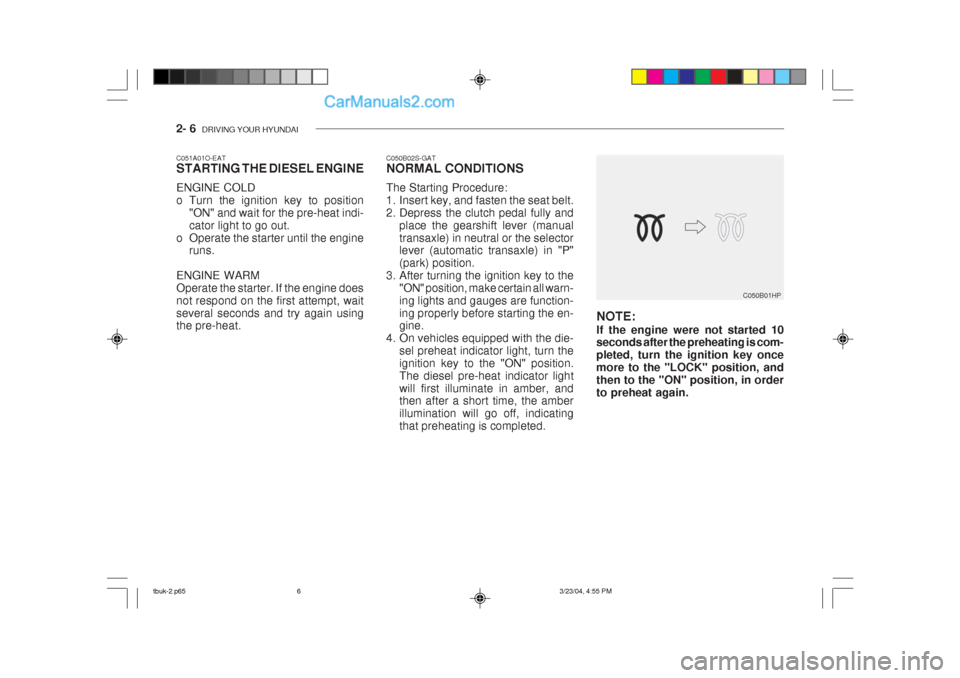
2- 6 DRIVING YOUR HYUNDAI
C050B01HP
NOTE: If the engine were not started 10 seconds after the preheating is com- pleted, turn the ignition key oncemore to the "LOCK" position, andthen to the "ON" position, in orderto preheat again.
C051A01O-EAT STARTING THE DIESEL ENGINE ENGINE COLD
o Turn the ignition key to position
"ON" and wait for the pre-heat indi-cator light to go out.
o Operate the starter until the engine runs.
ENGINE WARMOperate the starter. If the engine doesnot respond on the first attempt, waitseveral seconds and try again using the pre-heat. C050B02S-GAT NORMAL CONDITIONS The Starting Procedure:
1. Insert key, and fasten the seat belt.
2. Depress the clutch pedal fully and
place the gearshift lever (manualtransaxle) in neutral or the selector lever (automatic transaxle) in "P" (park) position.
3. After turning the ignition key to the
"ON" position, make certain all warn-ing lights and gauges are function-ing properly before starting the en- gine.
4. On vehicles equipped with the die-
sel preheat indicator light, turn the ignition key to the "ON" position.The diesel pre-heat indicator lightwill first illuminate in amber, and then after a short time, the amber illumination will go off, indicatingthat preheating is completed.
tbuk-2.p65 3/23/04, 4:55 PM
6
Page 350 of 445
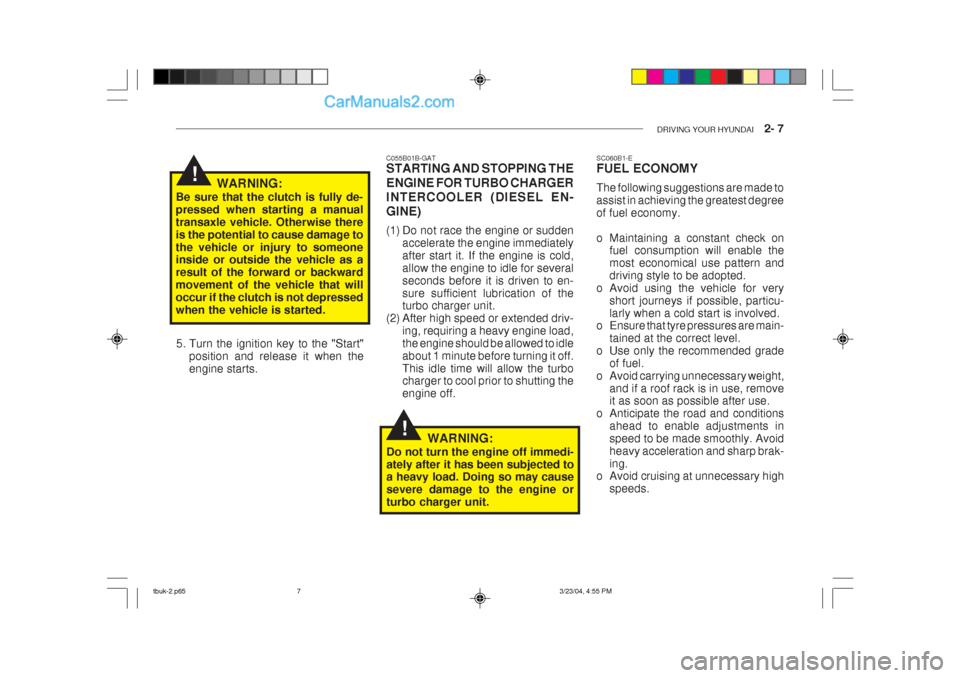
DRIVING YOUR HYUNDAI 2- 7
!
!
C055B01B-GAT STARTING AND STOPPING THE ENGINE FOR TURBO CHARGER INTERCOOLER (DIESEL EN-GINE)
(1) Do not race the engine or sudden
accelerate the engine immediately after start it. If the engine is cold,allow the engine to idle for severalseconds before it is driven to en-sure sufficient lubrication of the turbo charger unit.
(2) After high speed or extended driv- ing, requiring a heavy engine load, the engine should be allowed to idleabout 1 minute before turning it off.This idle time will allow the turbo charger to cool prior to shutting the engine off.
WARNING:
Do not turn the engine off immedi-ately after it has been subjected to a heavy load. Doing so may cause severe damage to the engine orturbo charger unit.
WARNING:
Be sure that the clutch is fully de-pressed when starting a manualtransaxle vehicle. Otherwise thereis the potential to cause damage tothe vehicle or injury to someone inside or outside the vehicle as a result of the forward or backwardmovement of the vehicle that willoccur if the clutch is not depressedwhen the vehicle is started. SC060B1-E FUEL ECONOMY The following suggestions are made to assist in achieving the greatest degreeof fuel economy.
o Maintaining a constant check on
fuel consumption will enable the most economical use pattern anddriving style to be adopted.
o Avoid using the vehicle for very short journeys if possible, particu-larly when a cold start is involved.
o Ensure that tyre pressures are main-
tained at the correct level.
o Use only the recommended grade
of fuel.
o Avoid carrying unnecessary weight,
and if a roof rack is in use, remove it as soon as possible after use.
o Anticipate the road and conditions ahead to enable adjustments in speed to be made smoothly. Avoidheavy acceleration and sharp brak-ing.
o Avoid cruising at unnecessary high
speeds.
5. Turn the ignition key to the "Start"
position and release it when theengine starts.
tbuk-2.p65 3/23/04, 4:55 PM
7